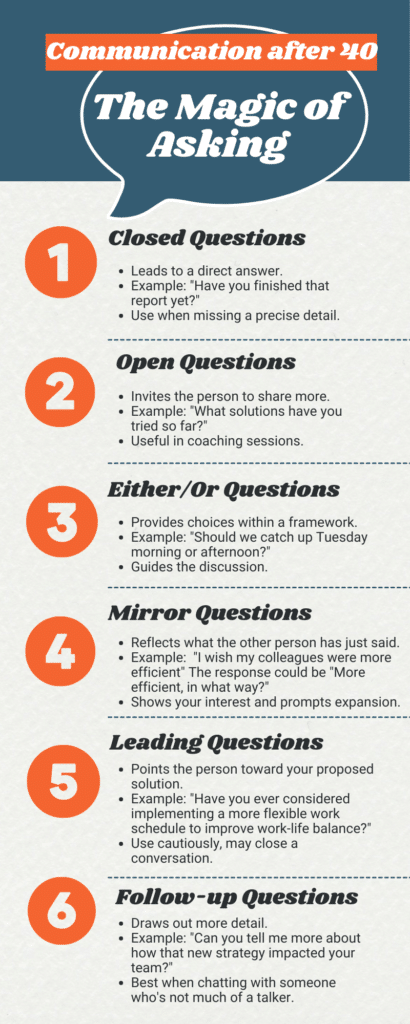Transform Communication After 40: Practical Strategies for Connection
So you’re over 40! You’re now in the decade of life that brings you a mix of confidence, wisdom, and, dare we say, a few forehead wrinkles. But this could also be the time to redefine how you connect with the world. This blog post will share some powerful and practical strategies to enhance communication after 40. Whether building rapport, fostering connections, or asking the right questions, these tried and tested methods promise a refreshing take on interaction and engagement.
Communication After 40: Creating a Connection

Building rapport with another individual is a critical component of effective communication. It serves as a bridge, facilitating mutual trust and understanding, making it easier to convey your message. Whether you’re interacting with a colleague, investor, or potential client, going beyond the superficial level of communication typical of most encounters can make a substantial difference.
There are proven strategies that can expediently establish a connection with your counterpart. Indeed, creating rapport – a deep sense of connection with another person – is something we do naturally. However, it often occurs on an unconscious level. Have you ever met someone and instantly felt a bond? You were in rapport with that person, perhaps without realizing it. The goal is to help you understand how to establish rapport when desired.
Rapport in Action
Let’s take a trip down memory lane. Remember when you were engrossed in a conversation with that charismatic neighbor at that weekend barbecue? You both leaned on the fence, mirroring each other’s casual stance. You laughed in sync, took sips of your drinks, and even your voices seemed to dance in the same rhythm. You were in a fascinating choreographed dance without even realizing it. This is the magic of connection at work. Our words matter, no doubt, but the secret sauce to influential communication is often hiding in the subtleties—your tone, the speed of your speech, the volume, body language, the timing of your breath, and those expressive gestures.
What happens when rapport is missing?
While on the other hand, when rapport is missing, things can turn out quite different. Imagine this: you’re on a mission to buy a new TV for the big game this weekend. You walk into a store, ready to get the lowdown on the latest models. You approach a salesperson, your voice steady, your speech slow and deliberate.
But here’s the catch: they respond with a sales pitch as rapid-fire as a sports commentator and as loud as the crowd at a packed stadium. You’re trying to keep up, feeling your patience wane and your ears ring. Five minutes in, you’ve had enough. You exit, TV-less, feeling like your needs were not heard or understood.
That is a prime example of how important it is to match your communication style with the person you’re interacting with to get your message across effectively.
But how do you build rapport?
Communication After 40: Steps to Build Rapport

Be Present
The first crucial step is to be fully present with the person you’re communicating with. It’s easy to be distracted by all the competing parts of our lives for our attention. Multitasking hampers the establishment of a strong connection. Hence, being completely present during your interaction is essential for optimal communication.
Mirroring
Observing and subtly mirroring the other person’s physiology can assist in rapport-building. Body language plays a vital role in communication. Therefore, adopting a similar posture to your conversation partner can enhance your connection. If the person crosses their arms, you might do the same after a few seconds. Do this subtly, waiting for an appropriate moment before mimicking their posture to appear more natural.
Moreover, try to mirror their gestures, from the tilt of their head to the movement of their hands. Again, subtlety is key. Human beings have 53 different facial muscles that allow us to express a vast array of emotions and communicate ideas non-verbally. Attempt to subtly mirror your conversation partner’s facial expressions, from raised eyebrows to blinking rates.
Adapt and Adjust Your Voice
When it comes to your voice, adjust the tone, volume, and speed subtly to match the other person. These changes should be minor enough to keep your voice recognizably yours. Mirroring these vocal attributes will aid in creating a sense of synchrony.
Reflect Back: Mimic words and phrases.
Finally, pay attention to the words your conversation partner uses frequently. We all have preferred words, expressions, and sentences, often related to our sensory channels. Identifying these and subtly incorporating them into your dialogue can enhance your connection.
Some might worry that modifying the way they speak might compromise their authenticity. However, the aim here is not to fundamentally alter your voice or terms but to make minor adjustments to align better with who you are communicating. You’re not changing your personality; you’re subtly adapting your manner of speaking, posture, and gestures to create a stronger connection.
These strategies will give your communication partner the impression of being understood, valued, and acknowledged. With practice, you’ll do all this naturally, without even realizing it, which is when the magic truly happens. Try these techniques and prepare to be amazed by the results.
Communication After 40: The Beauty of Bonding

The next important element of communication is that we tend to gravitate toward people like us. If we share similarities with someone, we’re more likely to appreciate them. And if we appreciate them, we’re more inclined to see things from their point of view.
There’s a significant amount of research that confirms that we like people who are like us. Other studies have found that meeting people similar to us can make us feel more confident, have more enjoyable interactions, and are more likely to have a mutual bond.
So, this is why looking for commonalities when in conversation is essential. It could be related to work, such as project management, team organization, or even a love for team-building activities. Or, it could be about personal interests like football, music, movies, or even a shared love for pets.
“But how do I find these similarities?” you might ask. Well, it’s simple. Just ask questions and show genuine interest in the other person. It’s as simple as that!
Communication After 40: The Magic of Asking

Let’s dive into the treasure chest of question types we can pop to others to gather the information we need. Each type has a specific function and goal, providing you with a versatile toolbox that you can use depending on the situation and your needs.
Closed Questions
First off, we have the “Closed Questions.” Picture these as a one-way street leading to a direct answer. “What time did you roll out of bed this morning?” or “Have you finished that report yet?” A simple “Yes,” “No,” or a specific detail is all you need. Use closed questions when you’re missing a precise detail to grasp a situation fully.
Open Questions
Next, let’s explore the world of “Open Questions.” You can’t answer these questions with “yes” or “no.” They invite the person to share more. “What solutions have you tried so far?” or “What’s your take on this?” These questions are the lifeblood of coaching sessions as they invite the person to share more, though sometimes, you might need to nudge them back to the main subject.
Either/Or Questions
Then there’s the “Either/Or Question.” It’s like a fork in the road where you’ve already chosen the paths. “Should we catch up Tuesday morning or afternoon?” These questions guide the discussion and can give the illusion of choice. It’s a favorite among salespeople and parents! “Will you tidy your room before dinner or after?”
Mirror Questions
Next, we have three other gems in our question toolbox. The “Mirror Question” reflects what the other person has just said, showing your interest and prompting them to expand. For example, if someone says, “I wish my team mates were more efficient”, your response could be “More efficient, in what way?” for instance.
The Follow-up Question
The “Follow-Up Question” is your best friend when chatting with someone who’s not much of a talker. It helps to draw out more detail. “Can you tell me more about how that new strategy impacted your team?” for example.
Leading Questions
Lastly, there’s the “Leading Question,” the question that subtly points the person toward your proposed solution. Have you ever thought about implementing a more flexible work schedule to improve work-life balance?” Be warned; these questions can sometimes close a conversation rather than open it up.
These six questions allow you to navigate any conversation with finesse and flexibility!
So, there you have it! Who knew the fine art of communication could be so nuanced, right? But now you’re ready to redefine your conversations, add a dash of charisma to your chats, and boost your connection game while keeping it real. Remember, it’s not about changing who you are but refining how you connect. So, go ahead, mirror a posture, echo a gesture, and dance along to the rhythm of rapport. Tune into the magic of shared interests and similarities. Sprinkle in a mix of open and closed questions, and voila! You’ve just mastered the recipe for robust communication after 40. Because, let’s face it, why should the 20-somethings have all the fun? Here’s to more meaningful conversations and stronger connections in our fab 40s and beyond!


